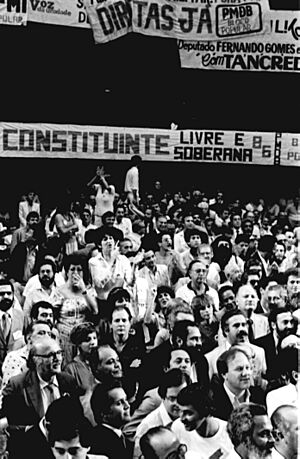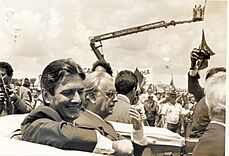History of Brazil (1985–present) facts for kids
Quick facts for kids
Federative Republic of Brazil
República Federativa do Brasil
|
|||||||
|---|---|---|---|---|---|---|---|
| 1985–Present | |||||||
|
Motto: Ordem e Progresso (Portuguese)
"Order and Progress" |
|||||||
|
Anthem: Hino Nacional Brasileiro (Portuguese)
"Brazilian National Anthem" Flag anthem: Hino à Bandeira Nacional (Portuguese)
"National Flag Anthem" |
|||||||
 |
|||||||
| Capital | Brasília 15°47′S 47°52′W / 15.783°S 47.867°W |
||||||
| Largest city | São Paulo 23°33′S 46°38′W / 23.550°S 46.633°W |
||||||
| Official language and national language |
Portuguese | ||||||
| Ethnic groups
(2010)
|
|
||||||
| Religion
(2010)
|
|
||||||
| Demonym(s) | Brazilian | ||||||
| Government | Federal presidential republic | ||||||
| Luiz Inácio Lula da Silva | |||||||
| Geraldo Alckmin | |||||||
| Arthur Lira | |||||||
| Legislature | National Congress | ||||||
| Federal Senate | |||||||
| Chamber of Deputies | |||||||
| Independence
from Portugal
|
|||||||
|
• Declared
|
7 September 1822 | ||||||
|
• Recognized
|
29 August 1825 | ||||||
|
• Republic
|
15 November 1889 | ||||||
|
• Current constitution
|
5 October 1988 | ||||||
| Area | |||||||
|
• Total
|
8,515,767 km2 (3,287,956 sq mi) (5th) | ||||||
|
• Water (%)
|
0.65 | ||||||
| Population | |||||||
|
• 2022 estimate
|
214,047,375 (7th) | ||||||
|
• Density
|
25/km2 (64.7/sq mi) (193rd) | ||||||
| GDP (PPP) | 2022 estimate | ||||||
|
• Total
|
|||||||
|
• Per capita
|
|||||||
| GDP (nominal) | 2022 estimate | ||||||
|
• Total
|
|||||||
|
• Per capita
|
|||||||
| Gini (2019) | ▼ 53.4 high · 10th |
||||||
| HDI (2019) | high · 84th |
||||||
| Currency | Real (R$) (BRL) | ||||||
| Time zone | UTC−2 to −5 (BRT) | ||||||
| Date format | dd/mm/yyyy (CE) | ||||||
| Driving side | right | ||||||
| Calling code | +55 | ||||||
| ISO 3166 code | BR | ||||||
| Internet TLD | .br | ||||||
|
|||||||
Brazil's recent history, starting in 1985, is often called the Sixth Brazilian Republic or New Republic. This period began when Brazil became a civilian government again. Before 1985, the country was under a military dictatorship for 21 years.
The change to democracy happened step-by-step. Tancredo Neves was chosen as the first civilian president since 1964. He was part of the Brazilian Democratic Movement Party (MDB). This party used to be the main opposition to the military government.
Sadly, Tancredo Neves became ill just before he could become president. His vice president, José Sarney, took over as acting president. When Neves passed away, Sarney officially became president. The first part of the New Republic, from 1985 to 1990, was a time of change. The old rules from the military time were still partly in place.
In 1986, people voted for a special group called the National Constituent Assembly. Their job was to write a new rulebook for the country, called a Constitution. This new Constitution was finished in 1988. It made Brazil a full democracy and replaced the old military laws.
In 1989, Brazil held its first direct presidential election since 1964. Fernando Collor won and became the first president under the new 1988 Constitution.
Since then, Brazil has had several presidents, all following the rules of the new Constitution:
- Fernando Collor (1990-1992): He faced serious accusations and resigned. His vice president, Itamar Franco, took over.
- Fernando Henrique Cardoso (1995-2002): He served two terms.
- Luiz Inácio Lula da Silva (2003-2010): He also served two terms.
- Dilma Rousseff (2011-2016): She was re-elected for a second term. However, she was removed from office in 2016 due to issues with budget laws. Her vice president, Michel Temer, became president.
- Jair Bolsonaro (2019-2022): He served one term.
- Luiz Inácio Lula da Silva (2023-present): He was elected for his third term.
Contents
- How Brazil Became a Democracy
- Economic Challenges in the 1980s
- The Return of Civilian Government (1985-1990)
- Collor and Franco Administrations (1990–1994)
- Cardoso Administration (1995–2002)
- Lula Administration (2003–2010)
- Rousseff Administration (2011–2016)
- Temer Administration (2016–2018)
- Bolsonaro Administration (2019–2022)
- Lula Administration (2023–Present)
- See also
How Brazil Became a Democracy
The last military president, João Figueiredo, started the process of making Brazil a democracy. He signed a law that forgave many people who had been punished by the military government. He wanted to open up the political system.
However, the change to democracy was not always easy. Some people who supported the military rule tried to cause problems. There were even some bombings. In 1981, a bomb went off too early, hurting two men. It was found that they were working with military groups. But no one was punished for this. This event made more people want to end military rule.
President Figueiredo also faced big problems like rising prices, less production, and a lot of foreign debt.
Economic Challenges in the 1980s
As Brazil became more open politically, its economy faced difficulties. In 1978 and 1980, large strikes happened in São Paulo. Workers said their wages were not keeping up with rising prices. Union leaders, like Luiz Inácio Lula da Silva, were arrested.
Brazil also had to follow a strict plan from the International Monetary Fund (IMF). This plan meant keeping wages low to fight inflation. In rural areas, poor people started to occupy unused land. This led the government to create a new ministry for land reform.
To deal with the huge debt, Figueiredo's government focused on selling more goods to other countries. These included food, natural resources, cars, and clothes. They also looked for more oil. Brazil wanted to make friends with any country that could help its economy grow.
In 1983, Brazil's economy got worse. Prices kept rising, and political leaders struggled. Millions of Brazilians went to the streets, demanding to vote directly for the next president. This movement was called "Diretas Já!" (Direct Elections Now!). But in 1984, Congress did not pass the law for direct elections. So, the president was chosen by a special group of voters.
The Return of Civilian Government (1985-1990)
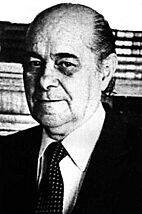
In 1984, many protests showed that military rule could not continue. People wanted to elect their president directly. The opposition party, the Brazilian Democratic Movement Party (PMDB), tried to pass a law for this. But the law did not pass because the government's party controlled Congress.
Tancredo Neves, a respected politician, formed an alliance of different parties. He ran as an opposition candidate and was elected president by Congress on January 15, 1985. However, he became very ill and passed away before he could take office.
His vice president, José Sarney, became president. Sarney's government kept Neves' promises. They changed the old Constitution and called for a National Constituent Assembly. This group wrote a new, democratic Constitution for Brazil. Ulysses Guimarães, a leader against military rule, led this Assembly.
The new Constitution was announced in October 1988. It brought back important rights like freedom of speech and free elections. It also gave more power to local and state governments.
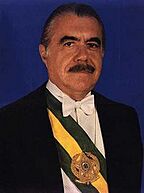
During this time, Brazil's economy struggled with very high inflation (prices rising fast). President Sarney tried several economic plans to control inflation. These plans included freezing prices and changing the national money. Brazil had three different types of money during his presidency.
Despite these efforts, inflation kept getting worse. This made the parties that led the change to democracy lose support. In 1989, Brazil held its first direct presidential election since 1964.
Collor and Franco Administrations (1990–1994)
Fernando Collor de Mello won the 1989 election. He became president on March 15, 1990. He focused on fighting corruption and finishing the move from military to civilian rule. He also wanted to control inflation and modernize the economy.
Collor's first big economic plan, called "Plano Collor," froze people's savings and changed the currency. It worked at first, but inflation soon returned. His policies also opened Brazil's economy to more international competition. This caused some companies to close and unemployment to rise.
In 1991, Collor's brother accused him of being involved in a money scheme. Congress and the police started an investigation. In August 1992, thousands of students protested against Collor. They painted their faces, earning them the nickname "Cara-pintada" (Painted Faces).
On August 26, 1992, a report confirmed that Collor had used money from illegal activities for personal expenses. Congress began the process to remove him from office. Collor resigned just before the Senate voted to impeach him. However, the Senate still voted to impeach him, which meant he could not hold political office for eight years.
His vice president, Itamar Franco, became president. Franco worked to create a new government with leaders from different parties. He appointed Fernando Henrique Cardoso as Minister of Treasury. Cardoso created a successful plan called "Plano Real" that brought inflation down a lot. This plan saved Brazil's economy from hyperinflation.

In 1993, Brazilians voted in a special election to decide their form of government. They chose to remain a republic, not a monarchy. They also chose to keep the presidential system. The presidential term was changed from five to four years.
In 1994, Fernando Henrique Cardoso was elected president.
Cardoso Administration (1995–2002)

Fernando Henrique Cardoso started his first term on January 1, 1995, and was re-elected in 1998. He wanted to bring stability and growth to Brazil. He also aimed to reduce the big differences between rich and poor people. He proposed changes to allow more foreign investment and to improve government spending.
His government is known for bringing economic stability after many years of very high inflation. During his time, many government-owned companies were sold to private businesses. New agencies were also created to oversee industries like energy and oil. Cardoso also focused on Brazil's relationships with other countries.
Lula Administration (2003–2010)
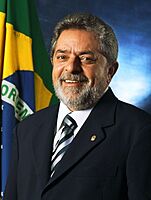
In 2002, Luiz Inácio Lula da Silva from the Workers' Party (PT) won the presidency. He was the first leftist president of Brazil. At first, prices rose because people were unsure about his economic plans. But Lula decided to continue the previous government's policies to keep inflation low. After this, Brazil's economy grew a lot, and more jobs were created.
In 2005, a case involving money payments to politicians came to light. This was called the "Mensalão scandal." Investigations showed that some politicians were paid to vote for government laws. The money came from private sources and government advertising budgets. Many people connected to the president were investigated.
Despite these issues, Lula remained very popular, especially among poorer people. Their income increased because of more jobs, easier access to credit, and government social programs. Brazil's economy was stable and growing, which helped Lula's popularity. He was re-elected in 2006.
After his second victory, Lula's approval ratings reached a record high. He focused on boosting the economy by investing in roads and other projects. He also made it easier for people and businesses to get credit. In 2009, the worldwide financial crisis briefly slowed Brazil's economy. But the government took steps to help, like reducing taxes on cars. This helped Brazil recover quickly.
Lula also worked to increase Brazil's influence around the world. He was a strong supporter of changing the United Nations Security Council to include more countries. He tried to be a peacemaker between different world leaders.
Rousseff Administration (2011–2016)
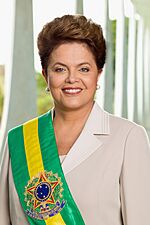
On October 31, 2010, Dilma Rousseff, also from the Workers' Party, became the first woman elected President of Brazil. She took office on January 1, 2011. Her main goals were to continue fighting poverty and to keep the economy growing.
She faced challenges like managing big building projects for the 2014 FIFA World Cup and the 2016 Summer Olympics. She also had to protect Brazil's economy from problems in Europe and the United States. These issues slowed down Brazil's economic growth compared to Lula's time.
In 2011, Rousseff started a program called "Brasil Sem Miséria" (Brazil Without Poverty). Its goal was to greatly reduce extreme poverty by the end of her term. This program expanded existing social welfare programs and created new job opportunities. In 2012, another program, "Brasil Carinhoso" (Caring Brazil), helped children living below the poverty line.
Even with some economic criticism, Rousseff's approval ratings were high until 2013. Then, many protests happened across the country. People were unhappy with public transport, healthcare, and education.
In 2014, Rousseff won a second term by a small number of votes. But her popularity continued to fall. By June 2015, her approval was very low. This happened after new information came out about many politicians, including some from her party. They were being investigated for taking money from the state-owned energy company Petrobras.
Temer Administration (2016–2018)
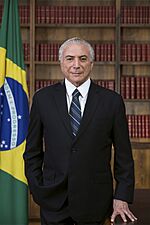
After the process to remove Rousseff from office began in late 2015, her vice president, Michel Temer, took over temporarily in May 2016. In August 2016, Rousseff was officially removed, and Temer became president until the end of the term. Brazil hosted the 2016 Summer Olympics during this time.
Temer became president during an economic crisis that started in 2014. He focused on reforms. His main actions included setting a limit on government spending and changing labor laws. In 2017, new accusations of corruption involved many politicians, including President Temer. He was accused of bribery, but Congress rejected the charge.
Former president Lula wanted to run for president again in 2018. But he was investigated and later arrested for money-related issues. He was released in 2019 after a court decision.
Temer was one of the most unpopular presidents in Brazil's history. He did not seek another term and left office with very low approval.
Bolsonaro Administration (2019–2022)
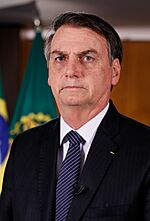
On October 28, 2018, Jair Bolsonaro, a right-wing politician and former army captain, was elected President of Brazil. He defeated Fernando Haddad and ended 16 years of rule by the Worker's Party. Many people had lost trust in political institutions due to a big corruption scandal. Bolsonaro was seen as an outsider who was tough on crime and corruption. He became president on January 1, 2019.
During Bolsonaro's first year, the cutting down of trees in the Amazon rainforest reached its highest level in 11 years. The Amazon is very important for fighting climate change. Bolsonaro's policies allowed more industry in the Amazon. This led to a big increase in Amazon rainforest wildfires in 2019.
In November 2019, his government approved changes to the pension system. These changes aimed to save a lot of money over 10 years.
In 2020, Brazil became one of the countries most affected by the COVID-19 pandemic.
Bolsonaro tried to win a second term in the 2022 Brazilian general election. However, he was defeated by former president Luiz Inácio Lula da Silva. This made him the first sitting president in Brazil to lose re-election since the rule was created in 1997.
The last two years of Bolsonaro's presidency had many disagreements between him and his allies and the Supreme Federal Court. After Lula's victory, some people close to Bolsonaro tried to stop Lula from becoming president. This is still being investigated.
Lula Administration (2023–Present)
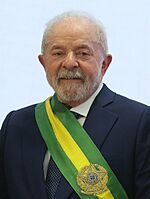
On October 30, 2022, former president Luiz Inácio Lula da Silva was elected for his third term. This was a special event because it was not a continuous term. He defeated the current president, Jair Bolsonaro.
In the first few days of his presidency, supporters of Bolsonaro stormed the main government buildings in Brasília. They refused to accept his defeat and demanded military action. This attack was compared to the attack on the U.S. Capitol in 2021.
In his first months, Lula removed the spending limit that the Temer government had created. In March 2023, his finance minister introduced a new financial rule, which Congress approved. In December 2023, the Chamber of Deputies approved a tax reform proposal. This was the first time such a reform was approved since Brazil became a democracy again.
See also
- List of years in Brazil
- List of scandals in Brazil





